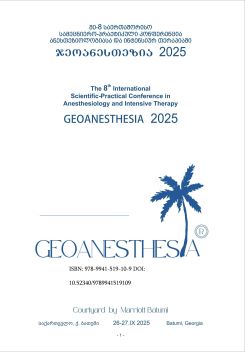S-Ketamine in the Management of Refractory Infantile Spasms: Evidence of Therapeutic Superiority and Clinical Implications from a Case Report of West Syndrome for Early Aggressive Intervention
DOI:
https://doi.org/10.52340/9789941519109.17საკვანძო სიტყვები:
Infantile spasms, West syndrome, S-ketamine, refractory epilepsy, pediatrics, NMDA antagonismანოტაცია
Introduction: Infantile spasms (IS), the defining electroclinical manifestation of West syndrome, represent a severe epileptic encephalopathy and a critical neurological emergency in early childhood. If inadequately or belatedly treated, IS frequently evolve into intractable epilepsy and are strongly associated with profound cognitive and developmental impairment [1]. Early and effective therapeutic intervention is therefore essential to prevent irreversible neurodevelopmental sequelae.
Current first-line therapies include adrenocorticotropic hormone (ACTH), corticosteroids, and vigabatrin; however, therapeutic resistance is common, and a substantial subset of patients progress to a multidrug-resistant phenotype [2]. This highlights the urgent need for alternative pharmacological strategies capable of achieving rapid electroclinical remission.
S-ketamine, the S (+) enantiomer of racemic ketamine, has emerged as a potential candidate due to its potent antagonism of N-methyl-D-aspartate (NMDA) receptors, a pathway implicated in epileptogenic and excitotoxic neuronal injury. Although preclinical and limited clinical data suggest anticonvulsant and neuroprotective properties, its therapeutic role in the management of IS remains insufficiently characterized and warrants further investigation [3].
Case Report: We describe a 6-month-old male infant, born at term with perinatal asphyxia (Apgar scores 4 and 7), presenting with epileptic spasms and developmental delay. EEG revealed hypsarrhythmia consistent with West syndrome. Despite sequential administration of vigabatrin, topiramate, levetiracetam, vitamin B complex, folic acid, and ACTH (last dose March 17, 2025), spasms persisted. Additional therapy with valproic acid (30 mg/kg/day) and prednisolone (8 mg/kg/day) also failed to achieve control.
Given refractory progression, S-ketamine was initiated in the pediatric intensive care unit. A 0.5 mg/kg IV bolus was followed by continuous infusion (1–5 mg/kg/h) over 72 hours. Sedation was maintained with low-dose midazolam, with continuous EEG and cardiorespiratory monitoring. Clinical spasms resolved within 8 hours. EEG at 24 hours showed disappearance of hypsarrhythmia, and complete electroclinical remission was achieved by 72 hours. Adverse effects were limited to transient tachycardia and post-infusion irritability. No major complications occurred.
Discussion: This case highlights the potential role of S-ketamine as a rapid-acting therapy in multidrug-resistant IS. Its NMDA receptor antagonism may counteract excitotoxic mechanisms contributing to epileptic encephalopathy [4]. The observed rapid remission, combined with a favorable safety profile, suggests that S-ketamine could be considered as an adjunctive therapy in refractory West syndrome, particularly when urgent seizure suppression is essential to prevent irreversible cognitive decline [5].
Conclusion: Early and aggressive therapeutic strategies are critical in infantile spasms. S-ketamine may represent a promising adjunct in refractory cases, warranting systematic investigation through controlled studies.
წყაროები
Wilmshurst JM, Gaillard WD, Vinayan KP, et al. Summary of recommendations for the management of infantile seizures: Task Force Report for the ILAE Commission of Pediatrics. Epilepsia. 2015;56(8):1185–1197.
Lux AL, Osborne JP. A proposal for case definitions and outcome measures in studies of infantile spasms and West syndrome. Epilepsia. 2004;45(11):1416–1428.
Löscher W, Rogawski MA. How theories evolved concerning the mechanism of action of barbiturates and benzodiazepines: From GABA to glutamate. Epilepsia. 2012;53:12–25.
Vutskits L, Xie Z. Lasting impact of general anesthesia on the brain: mechanisms and relevance. Nat Rev Neurosci. 2016;17(11):705–717.
Pavlovic M, et al. Ketamine and epilepsy: A systematic review. Front Neurol. 2021;12:665066.





